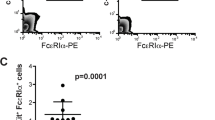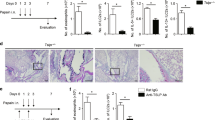Abstract
Airway hyperresponsiveness (AHR) is a hallmark of asthma1 and a heritable polygenic trait in the mouse2. In the mouse, candidate gene products of hematopoietic origin implicated in asthma mapped to the regions of the previously defined quantitative trait loci2. Since hematopoietic cells3–5 have been implicated in the pathogenesis of asthma, we evaluated the role of hematopoietic cells in general and T cells specifically in the genetic modulation of native airway responsiveness in mice. Here, with the use of bone marrow transplantation, anti-T-cell monoclonal antibody treatment and T-cell transfer, we demonstrate that intrinsic non-atopic AHR is mediated by T lymphocytes. Our data support the novel concept that, in the absence of identified environmental influences, T cells enhance genetically determined airway responsiveness.
This is a preview of subscription content, access via your institution
Access options
Subscribe to this journal
Receive 12 print issues and online access
$209.00 per year
only $17.42 per issue
Buy this article
- Purchase on Springer Link
- Instant access to full article PDF
Prices may be subject to local taxes which are calculated during checkout
Similar content being viewed by others
References
Guidelines for the diagnosis and management of asthma. National Heart, Lung, and Blood Institute. National Asthma Education Program. Expert Panel Report. J. Allergy Clin. Immunol. 88, 425–534 (1991).
De Sanctis, G.T. et al. Quantitative locus analysis of airway hyperresponsiveness in A/J and C57BL/6J mice. Nature Genet. 11, 150–154 (1995).
Busse, W. W. & Sedgwick, J. B. Eosinophils in asthma. Ann. Allergy 68, 286–290 (1992).
Sustiel, A. & Rocklin, R. T Cell responses in allergic rhinitis, asthma and atopic dermatitis. Clin. Exp. Allergy 19, 11–18 (1989).
Gordon, J. R. & Galli, S. J. Mast Cells as a source of both preformed and immunologically inducible TNF-α/cachectin. Nature 346, 274–276 (1990).
Mossman, T. R. & Coffman, R.L. THX1X and THX2X Cells: Different patterns of lymphokine secretion lead to different functional properties. Annu. Rev. Immunol. 7, 145–173 (1989).
Calvo, M. et al. Ten-year follow-up in pediatric patients with allergic bronchial asthma: Evaluation of specific immunotherapy. J. Invest. Allergol. Clin. Immunol. 4, 126–131 (1994).
Chang, T.L. et al. Heterogeneity of helper/inducer T lymphocytes: Lymphokine production and lymphokine responsiveness. J. Immunol. 145, 2803–2808 (1990).
Laitinen, L.A., Laitinen, A. & Haahtela, T. Airway mucosal inflammation even in patients with newly diagnosed asthma. Am. Rev. Respir. Dis. 147, 697–704 (1993).
Corrigan, C.J. & Kay, A.B. T Cells and eosinophils in the pathogenesis of asthma. Immunol. Today 13, 501–507 (1992).
Walker, C., Virchow, J.C., Jr., Iff, T., Bruijnzeel, P.L. & Blaser, K. T cells and asthma. I. Lymphocyte subpopulations and activation in allergic and nonallergic asthma. Int.Arch.Allergy Appl. Immunol. 94, 241–243 (1991).
Bradley, B.L. et al. Eosinophils, T-lymphocytes, mast cells, neutrophils, and macrophages in bronchial biopsy specimens from atopic subjects with asthma: Comparison with biopsy specimens from atopic subjects without asthma and normal control subjects and relationship to bronchial hyperresponsiveness. J. Allergy Clin.Immunol. 88, 661–674 (1991).
Renz, H. et al. Specific V beta T cell subsets mediate the immediate hypersensitivity response to ragweed allergen. J. Immunol. 151, 1907–1917 (1993).
Nakajima, H. et al. CD41 T-lymphocytes and interleukin-5 mediate antigen-induced eosinophil infiltration into the mouse trachea. Am. Rev. Respir. Dis. 146, 374–377 (1992).
Gavett, S.H., Chen, X., Finkelman, F. & Wills-Karp, M. Depletion of murine CD41 T lymphocytes prevents antigen-induced airway hyperreactivity and pulmonary eosinophilia. Am. J. Respir. Cell Mol. Biol. 10, 587–593 (1994).
Agosti, J.M. et al. Transfer of allergen-specific IgE-mediated hypersensitivity with allogeneic bone marrow transplantation. N. Engl. J. Med. 319, 1623–1628 (1988).
Moore, M.W., Cacalano, G., Wood, W.J. & Bailish, E. Neutrophilia in mice that lack the murine IL-8 receptor homolog. Science 269, 1590–1591 (1995).
Cobbold, S.P., Jayasuria, A., Nash, A., Porspero, T.D. & Waldmann, H. Therapy with monoclonal antibodies by elimination of T-cell subsets in vivo. Nature 312, 548–551 (1984).
Author information
Authors and Affiliations
Rights and permissions
About this article
Cite this article
De Sanctis, G., Itoh, A., Green, F. et al. T-lymphocytes regulate genetically determined airway hyperresponsiveness in mice. Nat Med 3, 460–462 (1997). https://doi.org/10.1038/nm0497-460
Received:
Accepted:
Issue Date:
DOI: https://doi.org/10.1038/nm0497-460



